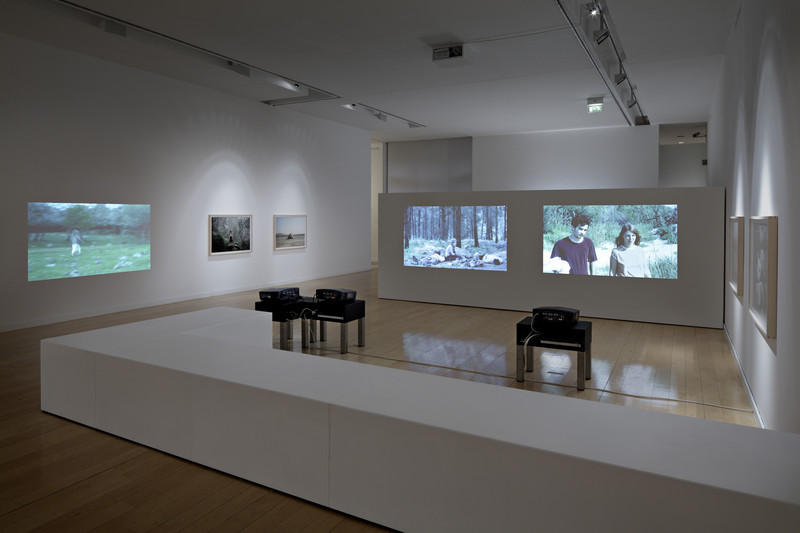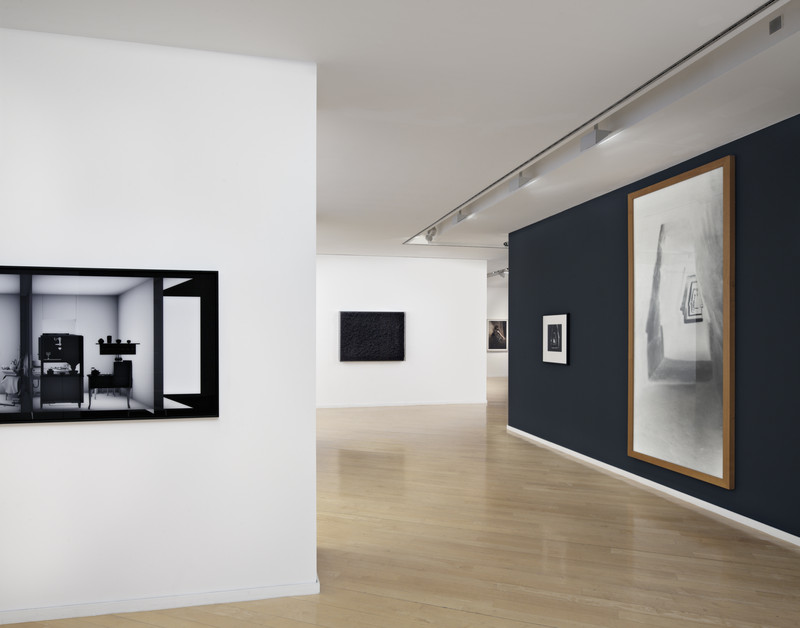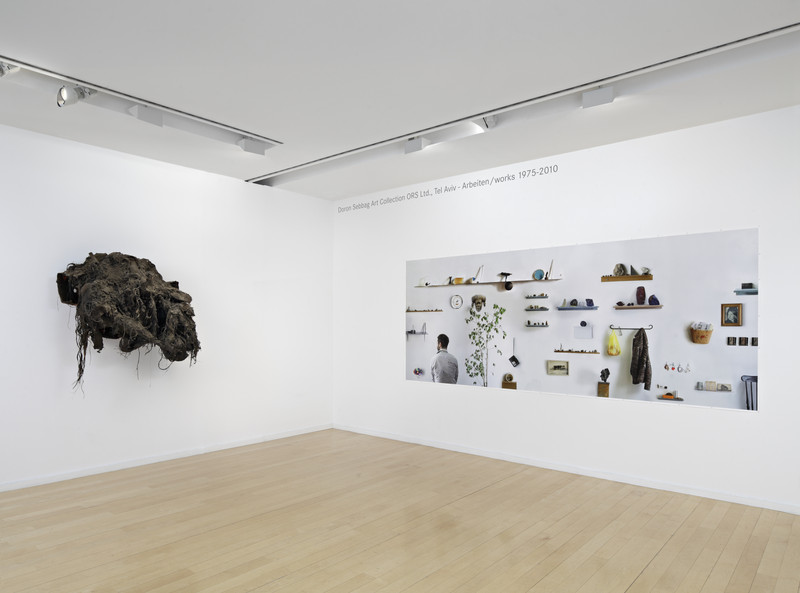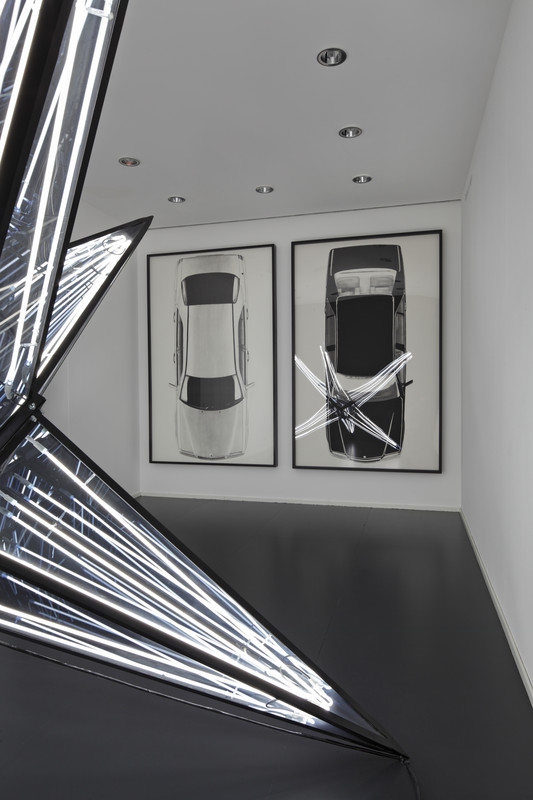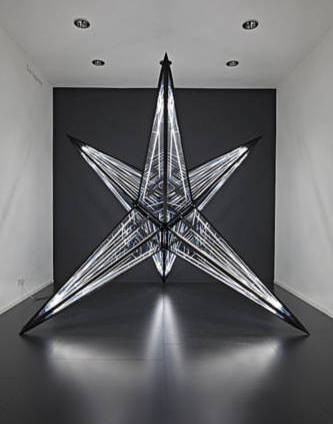Private/Corporate VII
17 Oct 2012 - 01 Apr 2013
The Doron Sebbag Art Collection, ORS Ltd., Tel Aviv, and
the Daimler Art Collection, Stuttgart/Berlin
17 October 2012 to March 2013
Daimler Contemporary Berlin
Curator: Renate Wiehager
The exhibition series ‘Private/Corporate’ - a series of dialogues between the Daimler Art Collection and domestic German and international private collections that began in 2002 - has, over the course of ten years or so, taken us on something of a journey around the world: the collections of our guests and dialogue partners have taken us to New York (the Sonnabend Collection, 2003), Mumbai (the Poddar Collection, 2007), Buenos Aires (the Vergez Collection, 2011) - and, most recently, to Tel Aviv! These collections, and of course those of our German partners Paul Maenz (2002), Heliod Spiekermann (2005) and Björn Lafrenz (2008) also, have presented us and our exhibition visitors with a multi-faceted panorama of contemporary art from circa 1960 to the present day: since 2002, around 100 artists from approximately 20 countries have been guests at the Daimler Contemporary gallery at Potsdamer Platz.
The Maenz, Sonnabend and Lafrenz collections, with their emphasis on conceptual art and minimalism, had much in common with the Daimler Art Collection. Our cooperations with the predominantly expressive and figural Spiekermann, Poddar and Vergez collections were more heterogeneous, although on the other hand this presented an opportunity to rediscover rarely-exhibited aspects of our collection.
Certain fundamental concepts that transcend stylistic and media categories emerged as common factors in the selection of artworks for our collaboration with the Sebbag Collection: narrative and temporal factors, expressive physicality and fetishism, existential codes and a mythically charged pictorial quality. The seventh exhibition in the ‘Private/Corporate’ series focuses on contemporary tendencies in art, both within Israel and internationally. Sebbag’s high-calibre collection consists of over 1,000 works and presents a varied, critically committed spectrum of contemporary Israeli and international art. The selection of approximately 40 works by about 20 artists from the Sebbag Collection is entitled ‘Accelerating Toward Apocalypse’ (first shown at Givon Art Forum, Tel Aviv, April-June 2012). Curator Tal Yahas made her selection with an eye to manifestations of time in contemporary art: archaeology, archives, the wasting of time and the obsession of capturing the moment are the key elements she has woven together. The selection of about 20 artworks from the Daimler Art Collection by international and Israeli artists responds to this theme with artworks that bring together politico-social analysis, existential ciphers and gestures and aspects of animism and fetishism. The focus is on new acquisitions from the collection.
Doron Sebbag is a collector who is passionate to the point of obsession. Together with his wife, Adi Sebbag, who is a lawyer currently practicing in Tel Aviv, he is always on the trail of the latest developments in art. This open-minded and inquisitive investigation is primarily carried on through encounters and friendships with artists and through Sebbag’s diverseinvolvement in promoting Israel’s contemporary art and museum scene, and, of course, through visits to international exhibitions and art fairs. This, in turn, is part of his diverse spectrum of activities, which includes supporting individual artists, publishing catalogues and realising art projects. Two thematic exhibitions of artworks from the Sebbag Collection have previously appeared at Israeli museums, ‘Quotations in Art’ (1996) and ‘Portraiture’s Many Faces’ (1996), plus two extensive showings of new acquisitions at the Tel Aviv Museum of Art, ‘Exposure’ (2000) and ‘Depletion’ (2008), curated by the long-time curatorial advisor Aya Lurie (see also: text in this catalogue by Dana Golan Miller, the collector’s curator in recent years). Some of the artworks in the collection were acquired to be exhibited on loan at the Artplus Hotel, or commissioned for specific spaces or situations. The Artplus Hotel Tel Aviv is a joint initiative by the Sebbag family, ORS Ltd. and the Atlas Boutique Hotels hotel chain. Doron Sebbag is currently employed at O.R.S.-Overseas Representation Services Ltd. in the position of Chief Executive Officer, President, and Chairman. O.R.S. Ltd. is a human resource company that offers recruitment and management services, primarily in the medical, health and welfare services sectors.
The visitor’s path through the exhibition at the Daimler Contemporary will be laid out based on resonances between thematic blocs of artworks from both collections. The tour will open with a group of artworks from the Sebbag Collection - anchored, mentally and thematically, by Hermann Nitsch’s early picture Relikt der 50. Aktion (1975). Whereas Nitsch’s abstract blood trail on canvas speaks to the imagination of the viewer, the sculptures by Sigalit Landau (an apparently skinned figure suspended from the ceiling, constructed from fibreglass) and Peter Buggenhout are geared toward an almost shocking, unmediated sensory physical confrontation. In the case of a shape alluding to a Gorgon’s head of the latter sculpture, this shock factor extends to the language of the materials: ‘polyester, papier mâché, iron, wood, plastic, household dust, horsehair, and blood’. The archaic, ritual aspects of these three artworks will be echoed by Ilit Azoulay’s two intellectually choreographed memory spaces created by means of photography: the large-format photograph The Keys (2010, Sebbag Collection), which shows a computer-designed wall display of found everyday objects - conserved with great attention to detail - and Transition (2009, Daimler Art Collection), which consists of a number of photographic found objects showing various different stage set-like spaces, nested one inside the other.
The main room of the Daimler Contemporary will be given over to five video artworks by three female Israeli artists from both collections. All five share an extremely reduced, minimalist language that largely dispenses with dialogue, depending solely on the sensory power of concentrated, slow image sequences which are sometimes repeated in the manner of a ritual. Michal Rovner’s video Notes (2001, Sebbag Collection), a joint project with the composer Philip Glass, shows silhouette figures in heavy coats passing through an open landscape scene of alternately sandy and snowy desert plains. They are answered by some of the
Daimler Art Collection’s newly acquired video artworks by Sigalit Landau and Amit Berlowitz. The investigations into the existential qualities of borders and borderline situations - physical, geographical and psychological - that are reflected in Rovner’s work also appears in Landau’s video Mermaids (three naked women at the sea’s edge, who leave traces in the sand to the rhythm of the waves) and Berlowitz’ subtly related mini-dramas (a child playing hide-and-seek
all alone in the wood / a young couple on a beach, seeking themselves spiritually and yet becoming lost). The typology of landscape oscillating between reality and dreamlike scenarios is echoed by a video of Uri Nir with hugh soft bubbles ‘overshadowing’ a meadow.
A third bloc of artworks - which are primarily taken from the Daimler Art Collection - represent the concepts named at the outset: expressive physicality and fetishism, existential codes and a mythically charged pictorial quality. Robert Mapplethorpe presents the body of a man of colour in sections against a black background, seeking the point where beauty becomes horror, the balance between aesthetic refinement and aggressive photographic ‘processing’ of the photographic ‘object’. Michael Sayles draws African sculptures inspired by the deity statues of the Dogon ancestor cult of southern Mali with the care of an Old Master and fuses them with implements encountered in Berlin’s S&M scene. Robert Longo is another artist who has been known across the world since the 1980s thanks to his virtuoso black- and-white drawing technique: we have displayed his large-format drawings of Mercedes automobiles, shown in top view and hung on the walls like fetishes, opposite an aggressive sculptural star by Guy Zagursky that dominates the space. To create his wall object Unforgiving (2006, Sebbag Collection), Damien Hirst sealed thousands of flies under a layer of resin - visualising the “cycles of life and death, creation and destruction” (Tal Yahas) and, like Mapplethorpe, penetrating into the borderland between the aesthetic and the horrific. The artistic articulation of the fusion of different worlds, primitivism - in the form of referential reworkings of indigenous tribal art - and the deliberate fostering of the ambiguity that arises when the figural and the abstract meet - these are key themes for the artists named here, and also for the sculptures of the young Berlin artist Madeleine Boschan, which are going to be exhibited in dialogue with the works of Hirst and Mapplethorpe.
Strategies of ‘repetition and wasting of time, compositions resting on repetition and on the squandering of time as a compulsion or a closed loop, compulsive repetition and arresting of the moment’ – these are the themes that Tal Yahas will present, with a combination of poetry and compelling clarity, at the conclusion of our exhibition tour – bringing together works from the Sebbag Collection, in the form of representative groups of artworks by artists such as Nan Goldin, Wolfgang Tillmans and Dash Snow. Her text ‘Accelerating Toward Apocalypse: The Contemporary Art Collection in Present Continuous’, to be published in the accompanying catalogue, is a detailed and reflective summation of her thoughts on the subject.
We would like to thank Adi and Doron Sebbag, who responded to our idea of a shared exhibition with great enthusiasm and provided extensive support. Thanks to Dana Golan Miller who had a major part in the initial show and who has been taking care of the logistic part. Tal Yahas, with her exhibition of artworks from the Sebbag Collection ‘Accelerating’, has provided the thematic keynote for this ‘Private/Corporate VII’ show.
Renate Wiehager
August 2012
-
Artists from the Doron Sebbag Collection
Dalia Amotz (IL), Ilit Azoulay (IL), Avner Ben-Gal (IL), John Bock (D), Peter Buggenhout (B), Ofri Cnaani (IL), Marlene Dumas (SA), Ori Gersht (IL), Nan Goldin (USA), Damien Hirst (UK), Andy Hope 1930 (Andreas Hofer) (D), Sigalit Landau (IL), Ryan McGinley (USA), Uri Nir (IL), Hermann Nitsch (A), Doron Rabina (IL), Michal Rovner (IL+USA), Dash Snow (USA), Wolfgang Tillmans (D), Banks Violette (USA), Guy Zagursky (IL)
Artists from the Daimler Art Collection
Ilit Azoulay (IL), Amit Berlowitz (IL), Madeleine Boschan (D), Günther Förg (D), Sigalit Landau (IL), Robert Longo (USA), Robert Mapplethorpe (USA), Michael Sayles (GB), Maja Zack (IL)
-
Private/Corporate VII
Die Doron Sebbag Art Collection, ORS Ltd., Tel Aviv,
und die Daimler Kunst Sammlung, Stuttgart/Berlin
17.10.2012 bis März 2013
Daimler Contemporary Berlin
Kuratorin: Renate Wiehager
Die Ausstellungsreihe ›Private/Corporate‹, welche die Daimler Kunst Sammlung seit 2002 in ein Gespräch bringt mit deutschen und internationalen Privatsammlungen, hat uns über den Verlauf von rund zehn Jahren eine kleine Weltreise beschert: die Sammlungen unserer Gäste und Dialogpartner führten uns nach New York (Sammlung Sonnabend, 2003), Mumbai (Sammlung Poddar, 2007), Buenos Aires (Sammlung Vergez, 2011) – und aktuell nach Tel
Aviv! Über diese Sammlungen, aber natürlich auch über unsere deutschen Sammlungspartner – Paul Maenz (2002), Heliod Spiekermann (2005) und Björn Lafrenz (2008) – eröffnete sich uns und den Besuchern unserer Ausstellungen ein facettenreiches Panorama der Gegenwartskunst von etwa 1960 bis heute: rund 100 Künstler aus etwa 20 Ländern waren seit 2002 zu Gast im Daimler Contemporary am Potsdamer Platz.
Gab es mit den Sammlungen Maenz, Sonnabend und Lafrenz zahlreiche Überschneidungen mit der Daimler Kunst Sammlung in den Bereichen Minimalismus und Konzeptkunst, so waren die Kooperationen mit den expressiv-figürlich geprägten Sammlungen Spiekermann, Poddar und Vergez eher durch Heterogenität bestimmt, gaben aber auch den Anlass, selten gezeigte Aspekte unserer Sammlung neu zu entdecken.
In der Begegnung mit der Sammlung Sebbag haben sich, jenseits stilistischer oder medialer Zuordnungen, wenige grundlegende Begrifflichkeiten als Schnittpunkte der Werkauswahl aus beiden Sammlungen herauskristallisiert: Narration und Temporalität, expressive Körperlichkeit und Fetischismus, existenzielle Chiffren und mythisch aufgeladene Bildlichkeit.
Für diese siebte Folge der Ausstellungsreihe ›Private/Corporate‹ steht die israelische Gegenwartkunst im Fokus. Sebbags hochkarätige, mehr als 1000 Werke umfassende Sammlung repräsentiert ein facettenreiches, kritisch-engagiertes Spektrum zeitgenössischer israelischer und internationaler Kunst. Die für Berlin getroffene Auswahl von rund 40 Werken und etwa 20 Künstlern/innen aus der Sammlung Sebbag ORS steht unter dem Titel ›Accelerating Toward Apocalypse‹ (erste Ausstellung im Givon Art Forum, Tel Aviv, April-Juni 2012). Die Kuratorin Tal Yahas hat ihre Auswahl Manifestationen der Zeit gewidmet: Archäologie, Archiv, Vergänglichkeit, das obsessive Ergreifen des Moments. Die Auswahl von rund 20 Werken internationaler und israelischer Künstler/innen aus der Daimler Kunst Sammlung antwortet dieser Thematik mit Werken, die politisch-gesellschaftliche Analyse, existenzielle Zeichen und Gesten sowie Momente von Animismus und Fetischismus aufeinander treffen lassen. Der Schwerpunkt liegt bei Neuerwerbungen für die Sammlung.
Doron Sebbag ist ein obsessiver, leidenschaftlicher Sammler, immer auf der Suche – gemeinsam mit seiner Frau Adi Sebbag, die als Juristin in Tel Aviv selbstständig ist – nach neuesten Entwicklungen in der Kunst. Basis dieser offenen, neugierigen Suche sind zunächst Begegnungen und Freundschaften mit Künstler/innen und Sebbags vielfältige förderndeAktivitäten in der zeitgenössischen Kunst- und Museumsszene in Israel, aber natürlich auch Reisen zu internationalen Ausstellungen und Messen. Dies wiederum ist Teil eines vielfältigen Spektrums von Aktivitäten, das von der Förderung einzelner Künstler über die Publikation von Katalogen bis zur Realisierung von Kunstprojekten reicht. Zwei Themenausstellungen aus der Sebbag Sammlung waren bisher in israelischen Museen zu sehen, ›Quotations in Art‹ (1996) und ›Portraiture’s Many Faces‹ (1996), sowie zwei umfassende Bestandsaufnahmen von Neuerwerbungen im Tel Aviv Museum of Art, ›Exposure‹ (2000) und ›Depletion‹ (2008), verantwortet von der langjährigen kuratorischen Beraterin der Sammlung, Aya Lurie (siehe auch in diesem Katalog den Text von Dans Golan Miller, seit einigen Jahren als Kuratorin der Sammlung tätig). Ein Teil der Sebbag Sammlung wurde als Leihgabe für das Artplus Hotel erworben bzw. für spezifische Räume und Situationen in Auftrag gegeben. Das Artplus Hotel Tel Aviv ist eine gemeinsame Initiative der Sebbag Familie ORS Ltd. sowie der Hotelkette Atlas Boutique Hotels. Doron Sebbag ist beruflich Präsident und CEO des Unternehmens ›O.R.S.-Overseas Representation Services Ltd.‹, ein Personalmanagement-Unternehmen, das Beschaffungs- und Verwaltungsdienste sowie Lösungen für den befristeten und unbefristeten Personalbedarf anbietet, Schwerpunkte sind die Bereiche Medizin, Gesundheit und Sozialwesen.
Der Rundgang durch die Ausstellung im Daimler Contemporary wird auf Resonanzen zwischen in sich thematisch definierten Werkblöcken aus beiden Sammlungen hin angelegt sein. Den Auftakt wird eine Werkgruppe aus der Sammlung Sebbag bilden, für welche ein frühes Bild von Hermann Nitsch, Relikt der 50. Aktion von 1975, als mentaler und thematischer Anker fungiert. Während Nitsch‘ abstrakte Blutbahn auf Leinwand die Vorstellung des Betrachters anspricht, steht bei den Skulpturen von Sigalit Landau (eine von der Decke hängende, wie gehäutet anmutende Figur aus Fiberglas) und Peter Buggenhout die fast schockhafte, unmittelbar sinnlich-physische Konfrontation im Zentrum – wofür bei dem einem Gorgonenhaupt ähnlichen Wandobjekt des letzteren schon die Materialsprache einsteht: ›Polyester, Papiermache, Eisen, Holz, Plastik, Hausstaub, Pferdehaar, Blut‹. Den archaisch-rituellen Aspekten dieser drei Werke stehen zwei fotografisch inszenierte, intellektuell choreographierte Erinnerungsräume von Ilit Azoulay zur Seite: das Großfoto The Keys (2010, Sammlung Sebbag) zeigt ein am Computer gebautes Wanddisplay akribisch konservierter Alltagsfundstücke, Transition (2009, Daimler Kunst Sammlung) schiebt fotografische Fundstücke verschiedener bühnenähnlicher Räume ineinander.
Der Hauptraum im Daimler Contemporary wird fünf Videoarbeiten dreier israelischer Künstlerinnen aus beiden Sammlungen vorbehalten sein. Alle Arbeiten eint eine extrem reduzierte, minimalistische Sprache, die auf Dialoge weitgehend verzichtet und ganz auf die sinnliche Macht verdichteter, langsamer, teils rituell wiederholter Bildsequenzen setzt. Michal Rovners Video Notes (2001, Sammlung Sebbag), ein Gemeinschaftsprojekt mit dem Komponisten Philip Glass, lässt Schattenrissfiguren in schweren Mänteln über ein offenes, zwischen Sand- und Schneewüste wechselndes Landschaftsszenario ziehen. Dem antworten neu erworbene Videoarbeiten der Daimler Kunst Sammlung von Sigalit Landau und Amit Berlowitz. Die existenzielle Befragung von Grenzen und Grenzsituationen – physischer, geographischer, psychologischer – spiegelt sich, wie bei Rovner, so auch in dem Video Mermaids von Landau (drei nackte Frauen am Meer, die im Rhythmus der Wellen Spuren in den Sand ziehen) oder in den subtil inszenierten filmischen Mini-Dramen von Berlowitz (ein Kind, das allein im Wald Verstecken spielt / ein junges Paar am Strand, das sich seelisch sucht und doch verliert). Die Typology von Landschaften oszillierend zwischen Realität und Traum wird aufgenommen in einem Video von Uri Nir, in welchem große Seifenblasen eine Wiese zu überschatten scheinen.
Ein dritter Werkblock, überwiegend aus der Daimler Kunst Sammlung, steht für die eingangs genannten Begrifflichkeiten ein: expressive Körperlichkeit und Fetischismus, existenzielle Chiffren und mythisch aufgeladene Bildlichkeit. Robert Mapplethorpe inszeniert vor schwarzem Grund ausschnitthaft den Körper eines Farbigen, den Umschlagpunkt zwischen Schönheit und Schrecken, ästhetischer Raffinesse und fotografisch-aggressiver ›Zurichtung‹ des fotografischen ›Objekts‹ suchend. Michael Sayles zeichnet mit altmeisterlicher Akribie afrikanische Skulpturen, die von Götterstatuen aus dem Ahnenkult der Dogon im südlichen Mali angeregt sind, und schmilzt diese mit Utensilien, die er in der Berliner S&M-Szene angetroffen hat. Mit seiner virtuosen Technik der Schwarzweißmalerei ist seit den 1980 er Jahren auch Robert Longo international bekannt geworden: seinen großformatigen Zeichnungen von Mercedes Automobilen, die in Aufsicht dargestellt wie Fetische an der Wand hängen, haben wir einen aggressiv raumbeherrschenden skulpturalen Stern von Guy Zagursky gegenübergestellt. Damien Hirst hat für sein Wandobjekt Unforgiving (2006, Sammlung Sebbag) tausende von Fliegen unter einer Harzschicht eingeschlossen – so die »Kreisläufe von Leben und Tod, Schöpfung und Zerstörung« (Tal Yahas) visualisierend und, wie Mapplethorpe, in einen Grenzbereich von Ästhetik und Schrecken vortreibend. Die künstlerische Artikulation der Verschmelzung unterschiedlicher Welten, der Primitivismus als zitierender Rückgriff auf indigene Stammeskunst, die forcierte Ambiguität im Grenzbereich von Figur und Abstraktion – das sind zentrale Themen der hier genannten Künstler, aber auch der Skulpturen der jungen Berliner Künstlerin Madeleine Boschan, die im Dialog mit Hirst und Mapplethorpe gezeigt werden.
Strategien der ›Wiederholung und Verschwendung von Zeit, Inszenierungen der Repetition und Vergeudung von Zeit als Zwang und Endlosschleife, Zwanghafte Wiederholung und Festhalten des Augenblicks‹ – das sind die Themen, die Tal Yahas bezwingend klar und zugleich poetisch zum Abschluss unseres Rundgangs mit Werken aus der Sammlung Sebbag in Szene setzt – mit exemplarischen Werkgruppen von Künstlern wie Nan Goldin, Wolfgang Tillmans oder Dash Snow. Ihr in diesem Katalog publizierter Text ›Schnellend Richtung APOKALYPSE. Die zeitgenössische Kunstsammlung als laufendes Projekt‹ fasst ihre Überlegungen detailliert und reflektiert zusammen.
Wir danken Adi und Doron Sebbag, die mit großem Enthusiasmus unsere Idee einer gemeinsamen Ausstellung aufgriffen und unterstützt haben. Dank auch an Dana Golan Miller, die an der ursprünglichen Ausstellung wesentlich Anteil und die Verantwortung für die Organisation der aktuellen Ausstellung hatte. Tal Yahas hat mit ihrer ursprünglich für Tel Aviv kuratierten Ausstellung ›Accelerating‹ aus der Sammlung Sebbag, die wir in ihren wesentlichen Grundzügen für Berlin adaptieren konnten, die thematische Ausrichtung dieser Schau ›Private/Corporate VII‹ vorgegeben.
Renate Wiehager
Im August 2012

